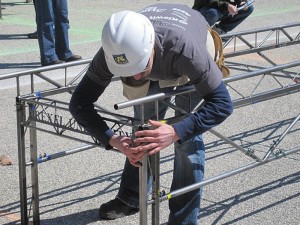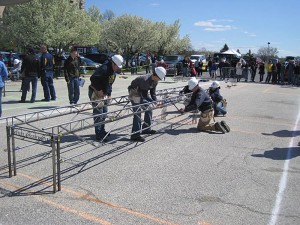Drexel University hosted the Mid-Atlantic region’s American Society of Civil Engineers’ Student Conference, which included the regional concrete canoe and steel bridge competitions, April 15-17.
The University placed second in the steel bridge competition, advancing to the national round, and placed third in the concrete canoe competition. The events took place at Cooper River State Park.
Drexel was the runner up to Lafayette at the 2011 regional bridge building event, which featured 12 colleges in total, the top three of which advanced to nationals. Pennsylvania State University finished third at the competition, in which the competing bridges were 22 feet long and contained a six-foot cantilever.

The colleges competed in six categories, with Drexel finishing first in lightness, display, stiffness and efficiency, with a second place in construction speed and third in economy. The competition began with a time trial during which the teams assembled their bridges. This construction activity was meant to simulate the construction of a full-size bridge, with students simulating trucks and barges that would be used in actual bridge construction.
The bridges then went through other tests for stiffness, sway and other measures. Drexel’s bridge was able to hold the maximum 2,500 pounds.
Drexel’s bridge had approximately one-fourth of an inch of sag in its back span and approximately one-eighth of an inch in its cantilever, making it the competition’s stiffest bridge. It also had a total sway of less than half an inch, the least sway of any bridge in the competition. Stadel said his team was “really nervous” about the bridge’s sway due to issues with this measure earlier in the building process.
Bridges that sagged more than one inch or swayed more than half an inch were disqualified.
“We were able to build a structure that exceeded the requirements,” Erik Colombo, a senior majoring in civil engineering and one of the project foremen, said.
Colombo added that Drexel’s overall competition score was among the top ten of all schools that participated in a regional competition.
“We’re shooting for top ten this year,” Stadel said.
The Drexel steel bridge team includes 32 students, 25 of whom participated in a special topics class related to the project that was held during the fall and winter terms. According to Colombo, students in the course decided on a bridge design in the fall and built the bridge in the winter. The building process has continued into spring term as well.
The team’s building strategy “has been a refinement of many years,” Colombo said.
Stadel said the most rewarding part of the process for him has been the strong student involvement and the effectiveness of the final product.
“We built everything by ourselves, so we had a lot of ownership,” Stadel said, adding that some universities in the competition built bridges that were not made purely by students.
Michael Whelan, a senior majoring in civil and architectural engineering and another foreman for the project, said some students on the team helped other students learn about the building process “to instill a sense of uniformity in fabrication.” Carl Oberg, a senior majoring in civil and architectural engineering, also served as a foreman for the project.

Colombo said the steel bridge team “has been instrumental to [his] understanding of leadership.”
Whelan said it has been rewarding “being able to work with other students, helping them develop their skills.” He said he hopes students participating in the project will be able to learn enough to build similar structures in the future.
The steel bridge team will participate in the national competition May 19-20 at Texas A&M University.
The concrete canoe competition featured canoe races between the five participating schools, as well as other elements including a design paper, oral presentation and aesthetics and durability judging. Each of these four elements was worth 25 percent of the total score, according to a College of Engineering press release. Drexel’s team placed first in the races, according to Aga Sidarta, a senior majoring in civil and architectural engineering and project manager for the concrete canoe team.
The concrete canoe team is fully student-run, according to Sidarta, who said the team organized the entire project, including planning the boat, mixing the concrete, pouring the concrete into a female mold and male mold and curing the canoe. The canoe building process began when the competition rules were released Sept. 1 and went until the competition in April.
The Drexel team named their canoe TiTANIC, with the ‘Ti’ at the start of the name representing the titanium dioxide in the team’s concrete mix. Titanium dioxide allows the concrete to be self-cleaning, according to Sidarta, who said the titanium dioxide cleans the pollution that comes from mixing the concrete and creating the boat.
This was the first year Drexel’s team used titanium dioxide in their canoe. Sidarta said the team decided to use it after reading about it in research papers and industry journals.
Drexel’s canoe also used self-consolidated concrete – a feature Drexel’s canoes often use in the competition, according to Sidarta, who said this type of concrete flows better and allows Drexel to cast the concrete faster.
Sidarta said he was pleased with the results of the event. “We really proved that Drexel has some fierce competition to offer,” he said.
Sidarta added that he has valued the contacts he was able to make through the canoe project. He also said he appreciates the project’s close connection with his major.
“Concrete is as hands-on as you can get with civil engineering,” Sidarta said.
Additionally, the process also helped his resourcefulness by forcing him to help build a project from scratch, while also helping him with skills like teamwork and researching, Sidarta said.
The University of Pittsburgh at Johnstown finished first in the competition, and the Naval Academy placed second, according to the Philadelphia Inquirer.
There is some overlap between the concrete canoe and steel bridge teams, according to Colombo. Both competitions are connected to the American Society of Civil Engineers, which organizes the concrete canoe competition. The ASCE is also the umbrella organization for the Architectural Engineering Institute, which organizes the steel bridge competition. The Drexel student chapters of the ASCE and AEI are primarily separate organizations.


